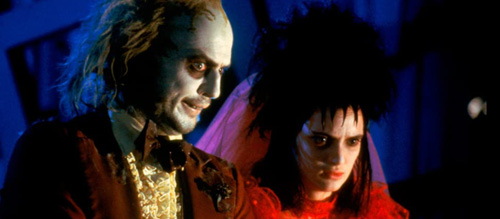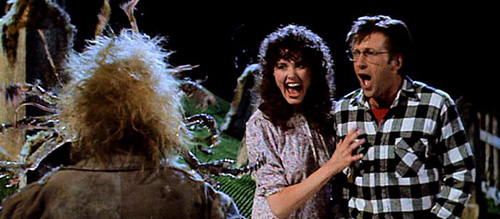Beetlejuice (1988) Review
Beetlejuice (1988)
Director: Tim Burton
Screenwriters: Michael McDowell, Larry Wilson, Warren Skaaren
Starring: Michael Keaton, Alec Baldwin, Geena Davis, Jeffrey Jones, Catherine O’Hara, Winona Ryder
Gentrification. Possession. Limbo. These may not be the first words that come to mind when describing 1988’s Beetlejuice. Yet these are key themes that make this not only an excellent horror comedy, but also a wonderfully strange piece of social commentary. Beetlejuice perfectly captures the anxieties that haunted 80s creatives, and it remains timeless no thanks to its purposefully cheap look and endlessly imaginative characters.
The plot follows Adam (Alec Baldwin) and Barbara (Geena Davis), a couple who, after dying a tragic death, attempt to scare away the new family that have come to inhabit their home. After numerous failed attempts, they decide to hire Betelgeuse (Michael Keaton), a bio-exorcist from the Netherworld.
When an almost offensively 80s family of yuppies come in to wreck a simple family home, they threaten to engulf the entire town into their pretentious lifestyle. A chaotic, destructive force. Yet they are never portrayed as evil. It could have been so easy for director Tim Burton to give into the 80s trend of the stereotypically unredeemable villains who the audience love to hate, such as the now redeemed Judge Doom from Who Framed Rodger Rabbit (1988). However, the family’s need for status and worship is a compulsion. They are conditioned to do their own good, trampling anyone else in the process. And this makes sense. The 80s were an intensely individualistic time, one that promoted extroversion and financial superiority. This aspect has been satirized in several film, including American Psycho (2000).
It tracks then that Burton would see the tendencies of this time as a threat to his world, built on authenticity and creative integrity. However, the underlying optimism which distinguishes this from Burton’s more pessimistic films, such as Edward Scissorhands (1990), lies in the ending: the new family is incorporated into the old house, with the strangeness of the Netherworld peacefully coexisting with the protagonists.
The characterization of the Netherworld is a highlight of this film. Beetlejuice fits into a particular subset of movies that doesn’t often get recognised: the procedural supernatural. These are movies where a fantastical setting, such as the afterlife, is reduced to just another step of a meaningless human existence. What is more human than expecting a spiritual experience, only to be met with a soul-sucking waiting room?
This is also a weirdly optimistic view of death, which is not uncommon for Burton. The horror of death is demystified, and dismissed right from the start when Adam and Barbara unsuccessfully attempt to scare the family with realistically gory depictions of death. Burton warns each of us upfront: reality does not matter. For instance, suicide depiction changes from a disturbingly realistic man in a closet to a disgruntled yet colourful employee, a mere cog in the bureaucratic machine.
In its cartoonish depictions, Beetlejuice delights in the macabre.

Michael Keaton only has 14.5 minutes of screen time as the titular character. This is common with a lot of movie villains: Dr Hannibal Lecter, Darth Vader and Pinhead all have under 20 minutes of screen time. And it can only work when the charisma of the performance colours the rest of the film. His absence serves to enhance his menace.
The movie succeeds because the rest of the cast is just as brilliant. Catherine O’Hara as Delia particularly shines in her role and provides the best moment in the film: a dinner possession scene. In fact, Beetlejuice continues in the glorious tradition of the comedy-horror-musical combination, seen in The Rocky Horror Picture Show (1975) and Little Shop Of Horrors (1986), with the terrifying and hilarious the Day O! scene. O’Hara leads the rest of the cast in a memorable display of physical comedy, while never neglecting the horror element. After all, this is a possession scene, and there are few more horrifying concepts than having something take over your body. The body horror is driven home by the iconic shrimp hands which, perfectly in line with the B-movie aesthetic of the film, abruptly put an end to the number.
Lastly, as with most Tim Burton films, is the look. From the set design to the Academy Award-winning make-up and hairstyling, Beetlejuice is not only consistent in its aesthetic, but it is also irreplaceable. This is exemplified by how, throughout its various iterations, from musicals to cartoons, costumes and set designs have maintained a similar look. It perfectly marries to the broad performances and their cartoonish tendencies, setting this world completely apart from our own. True escapism. The Netherworld, similarly to Corpse Bride (2005), is lively, thanks to the intentionally clunky combination of stop motion and practical effects. Beetlejuice himself could have come off as an overblown caricature, yet he fits in the world that Burton has created.
Beetlejuice is an incredible film. It weaves solid social commentary with deeply personal fears and is propelled forward by strong performances, a solid script and an impressive production. This is Tim Burton at his strongest.
Score: 24/24
Written by Elisabetta Pulcini
Recommended for you: Tim Burton Movies Ranked
You can support the author of this article, Elisabetta Pulcini, by following them and visiting their website:
Twitter – @ElisabettaPul
Website – elisabettapulcini


